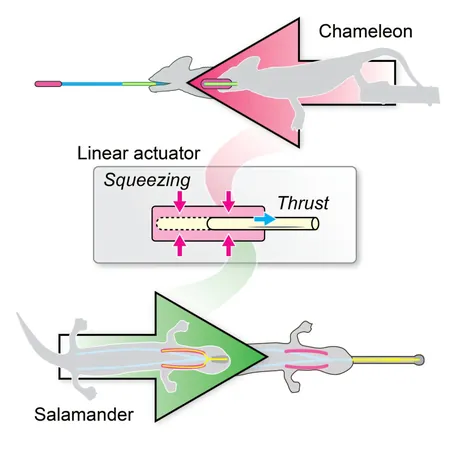
Unlocking Engineering Breakthroughs: How Salamanders and Chameleons Inspire the Future
2025-09-08
Author: Wei
Nature's Engineering Marvels
At first glance, the tongues of chameleons and salamanders may not appear to be the keys to the next wave of engineering innovations. However, groundbreaking research at the University of South Florida is bridging biology and engineering, revealing how these fascinating creatures might help tackle challenges both on our planet and beyond.
Unlikely Allies in Evolution
In a notable recent study, USF's postdoctoral researcher Yu Zeng and integrative biology Professor Stephen Deban have made a captivating discovery: despite their vastly different evolutionary paths and habitats, both salamanders and chameleons use a remarkably similar mechanism for launching their tongues at impressive speeds. Their findings, featured on the cover of Current Biology, unveil profound insights not only into animal motion but also into the potential applications inspired by these biological marvels.
Different Homes, Similar Mechanisms
While chameleons bask in warmer environments perched on trees and shrubs, salamanders thrive in the damp understory of forests and caves. Zeng noted, "They have never met in the wild, yet they’ve developed a comparable 'ballistic' tongue-launching system. It’s astonishing that they employ the same basic anatomical structures—such as tissues, tendons, and bones—that other vertebrates possess."
A New Perspective on Animal Movement
With over 30 years of experience studying animal physiology, Deban welcomed Zeng's expertise into his lab, paving the way for exciting interdisciplinary research. Zeng, whose previous work focused on insect flight, brought a novel angle on how animals navigate through their environments, shedding light on how those insights could be harnessed in technology.
Fast as Lightning: The Slingshot Effect
Through over a decade of video analysis collected in Deban’s lab, it was discovered that these agile creatures can propel their tongues at speeds of up to 16 feet per second. This groundbreaking study is the first to juxtapose these two species, revealing a shared mechanical model that operates like a slingshot—an insight that holds substantial engineering promise.
From Lab to Real-World Solutions
Zeng emphasized the versatility of this mechanism: "It can be scaled up or down and made from soft or flexible materials." The researchers are already in discussions with engineers about potential biomedical applications, such as devices designed to clear blood clots. Furthermore, the technology could lead to tools capable of retrieving objects from hard-to-access locations, be it a collapsed building or even outer space debris!
Bioinspiration: Future Prospects in Engineering
Deban and Zeng are eager to expand their research, not only to explore how these animal tongues project but also how they retract with impressive speed and accuracy. This endeavor is part of a burgeoning scientific movement known as "bioinspiration," which seeks to innovate materials, devices, or structures by mimicking solutions crafted by nature.
Nature’s Blueprint for Innovation
"It's immensely rewarding to weave a unifying narrative around these incredible tongues and their potential engineering applications after years of studying their biology," Deban remarked. "Nature has meticulously addressed these challenges; now, we're learning to adapt these natural solutions for human use."




 Brasil (PT)
Brasil (PT)
 Canada (EN)
Canada (EN)
 Chile (ES)
Chile (ES)
 Česko (CS)
Česko (CS)
 대한민국 (KO)
대한민국 (KO)
 España (ES)
España (ES)
 France (FR)
France (FR)
 Hong Kong (EN)
Hong Kong (EN)
 Italia (IT)
Italia (IT)
 日本 (JA)
日本 (JA)
 Magyarország (HU)
Magyarország (HU)
 Norge (NO)
Norge (NO)
 Polska (PL)
Polska (PL)
 Schweiz (DE)
Schweiz (DE)
 Singapore (EN)
Singapore (EN)
 Sverige (SV)
Sverige (SV)
 Suomi (FI)
Suomi (FI)
 Türkiye (TR)
Türkiye (TR)
 الإمارات العربية المتحدة (AR)
الإمارات العربية المتحدة (AR)